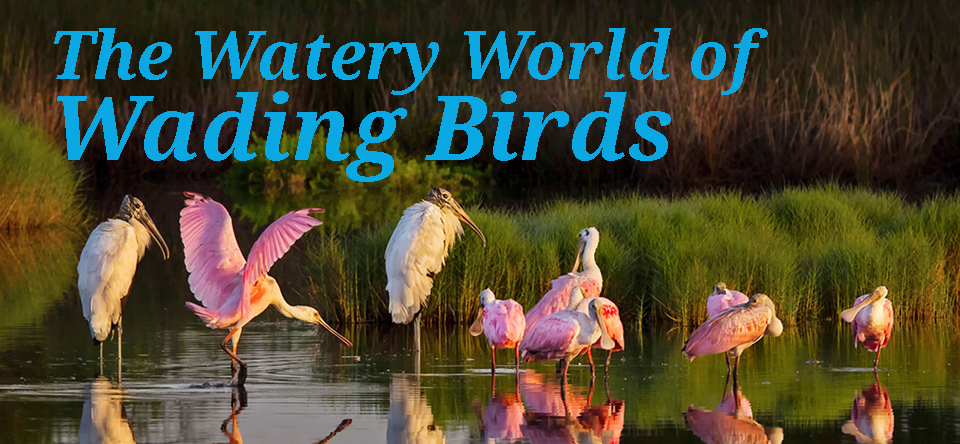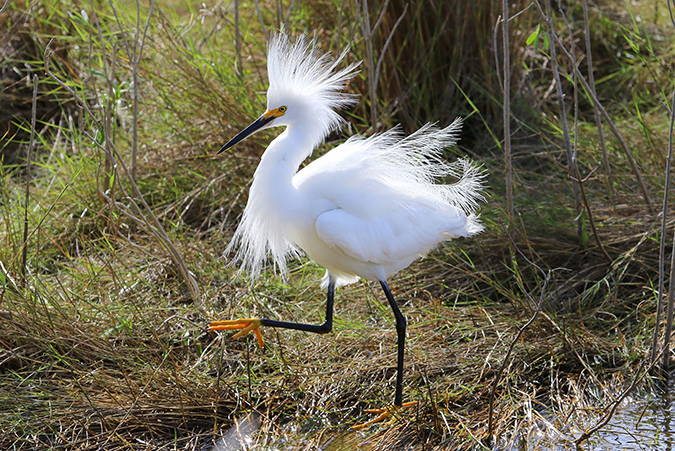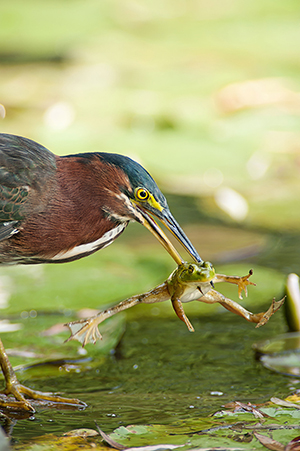
Audubon Adventures

Background for Teachers
Wading birds have physical and behavioral adaptations for living on or near water. While all animals need fresh drinking water, wading birds depend on water as a source of food, shelter, and nesting sites. The group includes cranes, herons, egrets, storks, spoonbills, and ibises.
Long Necks, Legs, and Toes

Wading birds do not swim or dive to catch food; rather they wade into shallow water to obtain food not found on land. A close look at the body of a wading bird reveals obvious characteristics that are useful in a watery habitat. A long neck is an adaptation that makes it possible to strike at prey while walking around on extra-long legs. Long legs help keep their feathers high and dry when wading into water in search of food. The benefits of wading birds’ long, thin, spread-out toes are threefold: Thin toes are easier to pick up and put down when walking in water and squishy mud. Spread-out toes keep them from sinking into soft mud in the water and at the water’s edge. And those toes also disperse the weight of these big, tall birds, helping them keep their balance over their long legs.

A Bill for the Job
Wading birds eat fish, crustaceans, mollusks, and other food. They don’t get all of their food from the water, however. Most also eat insects, small reptiles, and other prey found on land. Their bills exhibit special adaptations suited to their habitat and prey. The spear-like bills of herons and egrets are designed to grab and even stab fish. Cranes and ibises use their long bills to probe the mud and soil and forage in grass for food. The spoonbill holds its unique flattened bill partially open, sweeping it from side to side through the water. When it senses prey, the bill snaps shut.
Why Nesting Together Makes Sense
Most wading birds nest in colonies that often include various species of waders as well as other water-associated birds like gulls and cormorants. These colonies, called rookeries, offer specific advantages of safety and food supply for nesting birds. Because a nesting bird is sedentary, it is more vulnerable to predators and must choose its nest site carefully. If safe nest sites are in short supply, some bird species adopt the strategy of nesting in colonies because there is safety in numbers. With lots of birds in one place, each individual has a better chance of escaping an intruding predator. (This strategy works well for schooling fish, too.)
Another reason colonies are safer is that when there are many birds, there are more eyes and ears for detecting danger and sounding the alarm when a predator is near. Finally, when an intruder does threaten the colony, individual birds may join forces to drive it away.
Rookeries are usually located near or within flying distance of an abundant, concentrated food supply—a rich supply of fish and other live prey in and around adjacent waters, for example. Abundant food is necessary because wading birds are big, the rookery is large, and growing chicks are hungry!
A typical rookery, full of activity and noise, would likely get the attention of any predator in the vicinity. The eggs and nonflying young in the colony are vulnerable for a long period of time, promising a lot of food for a predator that can reach them. As a result, many wading birds nest on islands or over water in swamps where access by predators is limited. In Florida, for example, wading birds favor nesting on islands in lakes inhabited by alligators. These reptiles discourage raccoons from swimming to the islands where they would feast on the bird eggs.
Threats to Wading Birds
In addition to predators, threats to wading birds include natural phenomena such as storms and droughts that threaten their habitat and their young. Climate change compounds natural threats by increasing the intensity, frequency, and duration of weather events.

Until the early twentieth century, all wading birds were considered fair game for hunters in America. Birds were shot for food and for sport. Many were killed for their feathers alone to be used in the fashion industry. Entire colonies of nesting egrets were slaughtered to obtain feathers for hats. Fortunately, laws passed in the early 1900s put protections in play, and the populations of many species rebounded.
Today, habitat loss through human development is a major threat to wading birds. Diversion of water for irrigation and drinking purposes and the building of dams have also drained wetlands and reduced the amount of water flowing into rivers. A striking example is the reduction of habitat along the Platte River for migrating Sandhill Cranes. The half million cranes must now crowd into just one-fifth of the area they used to occupy before that river’s flow was reduced.
Humans have come a long way in sharing the world with wading birds. In just one hundred years we’ve progressed from wearing them as hats to using ultralight aircraft to teach young Whooping Cranes how to follow ancient migratory routes. That same spirit can work to keep habitats healthy, both for wading birds and ourselves.
Photos: John Studwell/Audubon Photography Awards; Gilberto Sanchez/Audubon Photography Awards; Michael Greer/Audubon Photography Awards.




